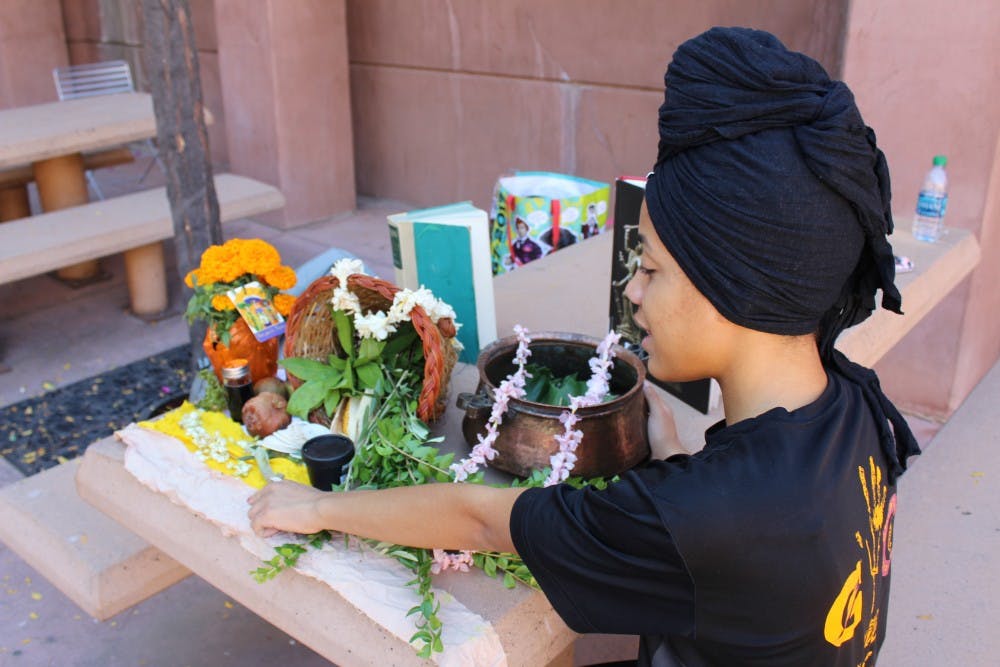Although Oct. 31 is most commonly associated with Halloween, it is also the day when many Pagans celebrate the harvest holiday of Samhain.
Samhain, sometimes considered the spiritual or Celtic new year’s day, is traditionally celebrated from sunset on Oct. 31 to sunset on Nov. 1 to coincide with traditional Celtic time keeping. However, some choose to celebrate it on the weekend before.
According to Viva Garrison, a graduate student studying linguistics and the president of ASU’s Pagan Student Alliance, the PSA held a private celebration on Oct. 28.
It is commonly believed that the Christian holidays All Saints’ Day and All Souls’ Day were at some point combined with Samhain to create what is today referred to as Halloween. Many Halloween traditions originated as part of Samhain celebrations, including dressing in costume and carving vegetables, according to Garrison.
Garrison said the first part of the celebration involved recognizing the surrounding land and spirits.
The PSA’s celebration this year was intended to “embrace eclecticism” of the different identities that fall under the Pagan identity, and to “contextualize it with what’s going on in Arizona.”
Next, she explained to the group how Samhain is a celebration of the harvest, including fruits, flowers and other plants, but also items and accomplishments made throughout the year.
“This is a physical harvest of things that we forage or grow,” Garrison said. “But also, we’re coming to the end of the academic year, and a lot of people have gone through midterms, and so there’s this harvest of the work that we’ve been doing as students.”
The next part of PSA's celebration was dedicated to ancestors. It included an altar, time for individuals to say the names of their family members who have died and lastly a toast, as “libations are pretty standard among all religions,” Garrison said.
Besides celebrating major pagan holidays, the PSA has meetings where they do divination and talk about different topics relating to paganism.
Read More: Range of alternative faiths find community under pagan umbrella
She is also a member of Sun Devils are Better Together, in which she participates in events where students hold up signs introducing themselves as members of their respective religions. They also invite strangers to have conversations with them about their practices.
Garrison said she has held up both the, ‘meet a Pagan’ and ‘meet a Pluralist’ sign, and she said the question she gets asked the most during those events is ‘what do you believe?’
“Paganism in general is more focused on orthopraxis and not orthodox, so I’m not really concerned about believing the right thing, but doing what you feel is right,” Garrison said.
There is no set way that all Pagans celebrate the holiday, and different sects or individuals may choose to honor their ancestors in different ways.
Keena Huesby, a junior theater major, is a member of the PSA, but says she wasn’t able to attend the Samhain celebration this year. However, she will be having a combined Halloween and Samhain celebration with her friends on Oct. 31.
“I like to set out a candle for each group of people,” Huesby said. “One for my ancestors, one for pets that have passed and one for people I don’t know – the forgotten people who may not have someone to remember them.”
Huesby said Samhain celebrations and symbols sometimes get a bad reputation — like black cats equating to bad luck —so she wants people to know that Samhain “is not creepy.”
“We make special cookies and we make soul cakes,” Huesby said. “It’s a fun holiday with food, just like every other celebration.”
Various Pagan churches in Arizona also celebrated Samhain this weekend, including Grove of the Rising Phoenix which held a public Samhain celebration on Oct. 29 at the Irish Cultural Center in Downtown Phoenix. The church emphasized the importance of the event being a time to remember and honor the dead, not to mourn them, and that it should be a fun, joyous occasion.
“We like it to be somber yet joyful,” said Michelle West, the elected president of the Grove of the Rising Phoenix. “It really goes back to ancestor veneration and what’s considered to be an in-between time, which is very prevalent to the Celtic cultures.”
At the event, participants were given a hazelnut to represent an ancestor. Each person gave their hazelnut to one of three people who represented the goddess Morrigan. One of the three representatives would put the hazelnut into a fire as an offering to the gods, said Mark Bailey, a church member who led the Grove's celebration.
Bailey said Samhain was historically a time of peace, and a time when it's easier to contact the dead.
“(Samhain) is a time of cooperation, a time to put the weapons aside and get together,” Bailey said, “and the Irish specifically believed that the ancestors were easier to contact during this time frame.”
Reach the reporter at abpotter@asu.edu and follow @abpotter4 on Twitter.
Like The State Press on Facebook and follow @statepress on Twitter.




